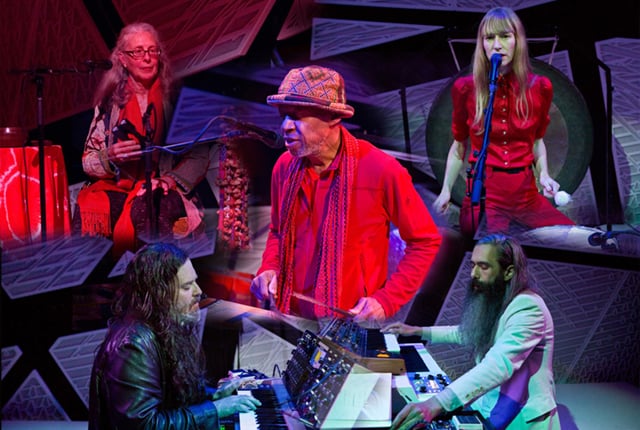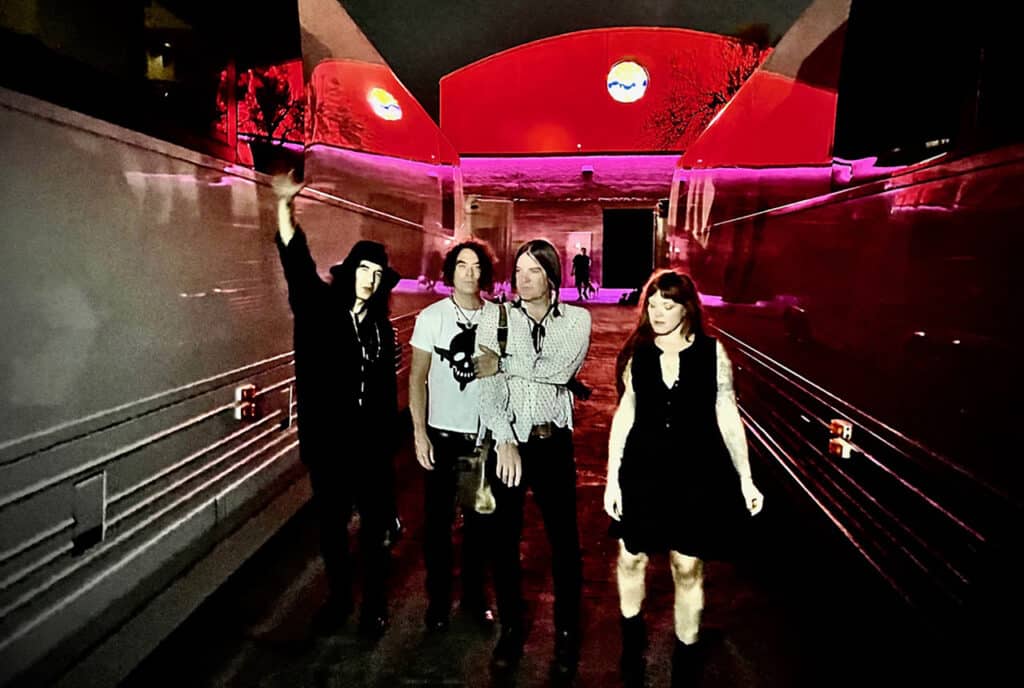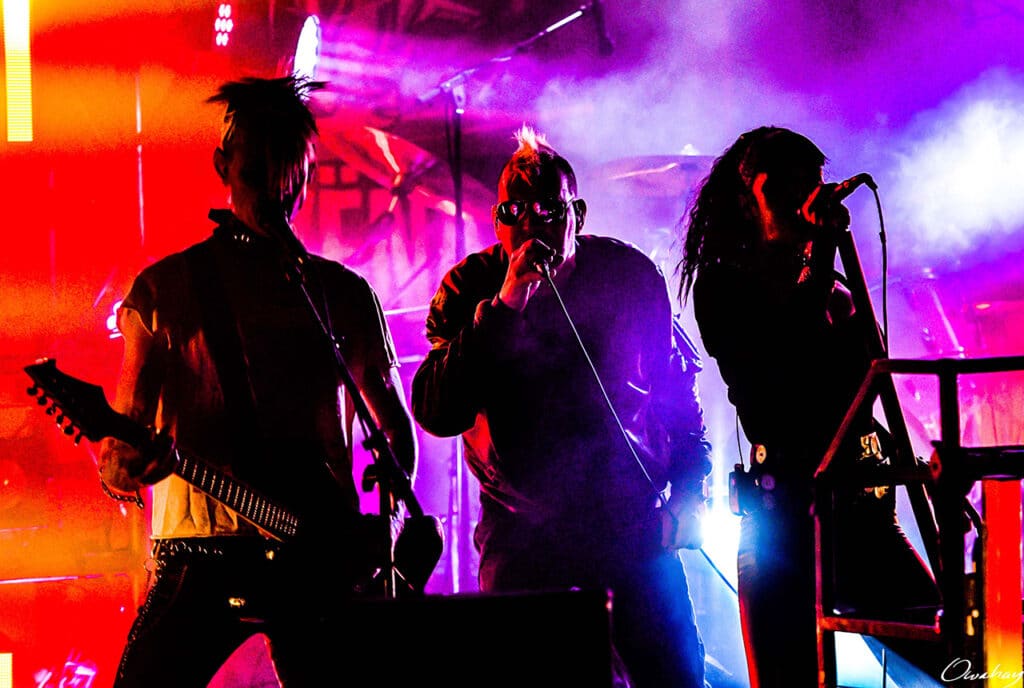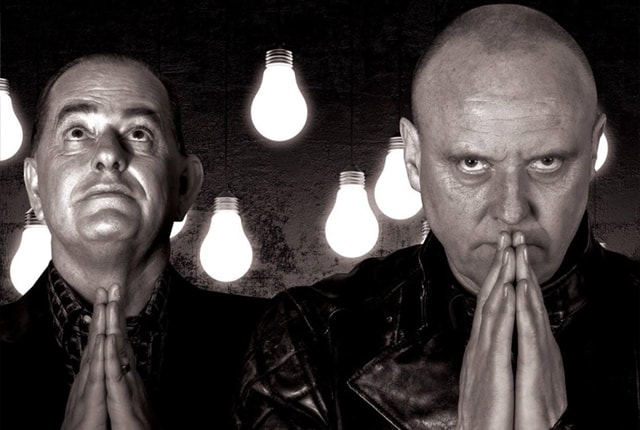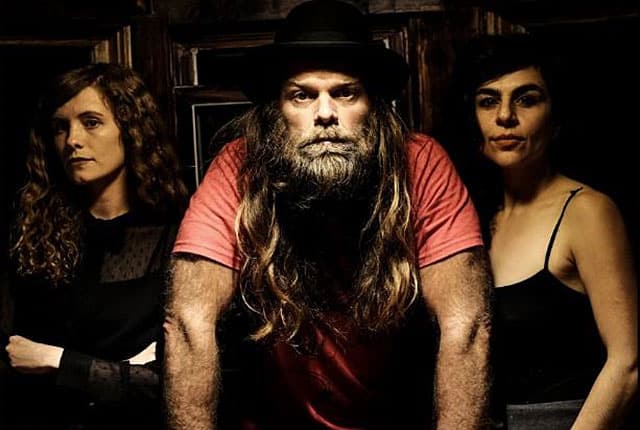“Arrive Without Leaving” is a mesmerizing adventure into sonic experimentation that brings together musical visionaries LARAAJI, Dallas Acid, and Arji OceAnanda. The project began when Dallas Acid sought out LARAAJI to share a bill at New York venue National Sawdust. Their label suggested that they spend some time in the studio together, and the resulting six-hour session provided the raw material for “Arrive Without Leaving.”
Dallas Acid is a synth-based trio from Austin, TX who draw inspiration from 1970s German and French electronic music, early minimalism, and ambient music. Since 2015, they have performed in planetariums, galleries, theaters, churches, and other unconventional spaces. Born Edward Larry Gordon, LARAAJI is a multi-instrumentalist best known for his work on the self-designed, electrified zither. His first release as LARAAJI was 1980’s Brian Eno-produced “Ambient 3: Day of Radiance.” Arji OceAnanda (Cakouros) is a sound healer, musician, Reiki master and Dreamwork teacher who had worked with LARAAJI previously.
In a phone interview, Dallas Acid members Linda Beecroft, Michael Gerner, and Christian Havins discussed the making of the album.
How did the collaboration “Arrive without Leaving” come about?
Linda Beecroft: “We were going to New York to play a show, and we were thinking about who we should play with. Suddenly, we had an idea to ask LARAAJI to play the show with us. One thing led to another. Our record label Flying Moonlight suggested we book a day in the studio after the show to see what happened. It was kind of quite simple and it happened very fast.”
Did you discuss or prepare for the recording in advance?
Linda Beecroft: “We did not have many plans, honestly. The only plans were basically to show up, set up, and see what happened. We just kind of all got in there together. There was a pretty long setup time in the studio to record it right, so we were patient and then when everything was set up, we started playing together. The only question that was really asked was, what key are we playing?”
Did the previous night’s performance have an impact?
Linda Beecroft: “It was our first meeting, the night before. That really impacted it, the meeting in general. It was really positive. We got to see them live for the first time as well that night. I think it gave the underlying tone for the next day in the studio.”
Did not having all your normal studio equipment affect your approach to recording?
Christian Havins: “I think it definitely did. We normally use a big modular as sort of the primary songwriting tool for Dallas Acid. We nicknamed it The Brain, the modular, but this time Laraaji drove the initial direction of the recording.”
What was the process like putting the actual album together after the recording session?
Linda Beecroft: “Well, we waited a little bit to listen back, and I feel we all had a similar experience while we were in the studio. We couldn’t really remember what had happened. We were all really in it and then it was over so quickly, and then we took a little break and started listening back and started finding key moments that all went together somehow. It took a long time listening back and figuring out an order and themes, but it was all in there.”
Christian Havins: “As a band, we spent a lot of time listening back to the recordings, and we were in constant communication with Laraaji and Arji during the process. We all picked out favorite moments from the six hours or so of recordings that we had. There were certain moments that had certain motifs that gelled together. So, a lot of it was picking these out and trying to come up with two 20-minute sides or just some great moments that we felt defined the day of the recording in a 40-minute format. “
Going into it, were you intending to do a 40-minute release? Did you consider a double album? Have you thought about further releases based on the session?
Christian Havins: “I think we went into it thinking that if we could get a solid 40 minutes out of the process, that would be really a victory, for sure. But there was so much more when we listened back. So, we immediately started grouping different parts of the recording together into similar themes. The possibility of a volume 2 or a volume 3 was definitely talked about, but we would have to discuss it more and really make some more hard editing decisions.”
Was picking what to use a challenge?
Christian Havins: “Definitely, I think so. There were so many moments where we were locked in to a collective moment. There were so many beautiful moments that maybe went over our heads at the time. Listening back, there were a ton of those. So, picking 40 minutes of our favorites was tough.”
Will you be performing this material live?
Christian Havins: “Well, actually we did a collaborative performance here in Austin. They were in Austin and we did a similar thing to what we did at National Sawdust in New York. We opened for them at the Texas Theater in Dallas and then at the Zack Scott Theater in Austin. We also went to a park where there was a weekend jam session setup and we basically tried our first attempt at material that represents the record live. I thought it went over really well.”
You’ve performed at a lot of interesting venues over the years. What do you think the ideal setting is for your music?
Michael Gerner: “Ideally, it would be best if it wasn’t necessarily a rock venue on a Friday night where people really want to get wild. We’ve done that before, and it works out, but we’re often lumped with other performances where you just feel like a speed bump in the whole arc of the show. So, we’ve been trying to play more unconventional places where we can set the mood.”
Christian Havins: “Where people are comfortable and can actually listen.”
Linda Beecroft: “Well, ideally the performance will be in a place where the people can feel comfortable and relaxed and soak in the music rather than fighting to hear it.”
Christian Havins: “A meditative environment is probably the best way to experience it, I would guess. But we’ve played festivals and metal shows and all kinds of other things and had a great time. But for a lot of what we do, I think an environment like a theater is really good. We’ve played drive-in theaters and planetariums and that kind of thing as well, and that translates environmentally as a good spot to experience Dallas Acid.”
What is your equipment setup generally like?
Christian Havins: Michael and I both play Moog synthesizers; I play a Voyager, he plays a Sub 37 and then also he plays a mellotron. The main piece of gear is The Brain.
Could you describe The Brain?
Michael Gerner: “It’s a pretty large modular synth that I’ve been working on for 15 years. I started off with primarily a .COM format from Tylor, Texas. In the last handful of years, I’ve been branching out with other brands like Moo Modular, Core Synth and Free State Effects. They’re all the Moog format, larger models. Predominately, we’ve been using it for sequencing and then we might add it at the end of the recording process. But it’s usually for the songs where we have sequenced drive. We create it with that. I don’t know if I have a complete understanding of it, but I get around it and it kind of creates things for me. I feel like that’s the beauty of it. You do an experiment to try something new out and then, of course, you have to adjust the notes, but in general, it usually plays back something that I don’t think any of us would have originally come up with on our own accord. You always want to expand and outdo your last patch and try to figure it out. And it always comes back with something new as well.
Have you ever used it for live performances?
Michael Gerner: “We’ve brought it out a couple times. One time was for South by Southwest and it was very humid and half of it went out. I was pretty nervous that it was a very expensive mistake. I got it all back working the next day by freezing the house. We did perform with it at a planetarium, just for the simple fact that we were the only band and had 4 hours or setup time and it was temperature controlled. Generally we record with it and then loop the sequences live. “
Are you working on a new Dallas Acid album?
Linda Beecroft: ”Yeah, we have an album we’ve been working on for a while. Well, we have a few albums we’ve been working on for a while, but one album is very close to being done and we hope for a release early next year for a new Dallas Acid album.”
To hear samples from and purchase the album, visit the Bandcamp page.
For more info in Dallas Acid, visit dallasacid.com.
